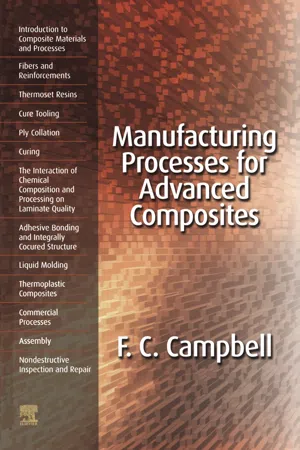
- 532 pages
- English
- ePUB (mobile friendly)
- Available on iOS & Android
eBook - ePub
Manufacturing Processes for Advanced Composites
About this book
• One of very few books available to cover this subject area.• A practical book with a wealth of detail.This book covers the major manufacturing processes for polymer matrix composites with an emphasis on continuous fibre-reinforced composites. It covers the major fabrication processes in detail.Very few books cover the details of fabrication and assembly processes for composites. This book is intended for the engineer who wants to learn more about composite processing: any one with some experience in composites should be able to read it. The author, who has 34 years experience in the aerospace industry, has intentionally left out mathematical models for processes so the book will be readable by the general engineer. It differs from other books on composites manufacturing in focussing almost solely on manufacturing processes, while not attempting to cover materials, test methods, mechanical properties and other areas of composites.
Frequently asked questions
Yes, you can cancel anytime from the Subscription tab in your account settings on the Perlego website. Your subscription will stay active until the end of your current billing period. Learn how to cancel your subscription.
No, books cannot be downloaded as external files, such as PDFs, for use outside of Perlego. However, you can download books within the Perlego app for offline reading on mobile or tablet. Learn more here.
Perlego offers two plans: Essential and Complete
- Essential is ideal for learners and professionals who enjoy exploring a wide range of subjects. Access the Essential Library with 800,000+ trusted titles and best-sellers across business, personal growth, and the humanities. Includes unlimited reading time and Standard Read Aloud voice.
- Complete: Perfect for advanced learners and researchers needing full, unrestricted access. Unlock 1.4M+ books across hundreds of subjects, including academic and specialized titles. The Complete Plan also includes advanced features like Premium Read Aloud and Research Assistant.
We are an online textbook subscription service, where you can get access to an entire online library for less than the price of a single book per month. With over 1 million books across 1000+ topics, we’ve got you covered! Learn more here.
Look out for the read-aloud symbol on your next book to see if you can listen to it. The read-aloud tool reads text aloud for you, highlighting the text as it is being read. You can pause it, speed it up and slow it down. Learn more here.
Yes! You can use the Perlego app on both iOS or Android devices to read anytime, anywhere — even offline. Perfect for commutes or when you’re on the go.
Please note we cannot support devices running on iOS 13 and Android 7 or earlier. Learn more about using the app.
Please note we cannot support devices running on iOS 13 and Android 7 or earlier. Learn more about using the app.
Yes, you can access Manufacturing Processes for Advanced Composites by Flake C Campbell Jr in PDF and/or ePUB format, as well as other popular books in Technology & Engineering & Industrial Engineering. We have over one million books available in our catalogue for you to explore.
Information
Chapter 1 Introduction to Composite Materials and Processes: Unique Materials that Require Unique Processes
A composite material can be defined as a combination of two or more materials that results in better properties than when the individual components are used alone. As opposed to metal alloys, each material retains its separate chemical, physical and mechanical properties. The two constituents are normally a fiber and a matrix. Typical fibers include glass, aramid and carbon, which may be continuous or discontinuous. Matrices can be polymers, metals or ceramics. This book will deal with continuous and discontinuous fibers embedded in polymer matrices, with an emphasis on continuous-fiber high-performance structural composites. Examples of continuous reinforcements include unidirectional, woven cloth and helical winding, while discontinuous reinforcements include chopped fibers and random mat (Fig. 1).
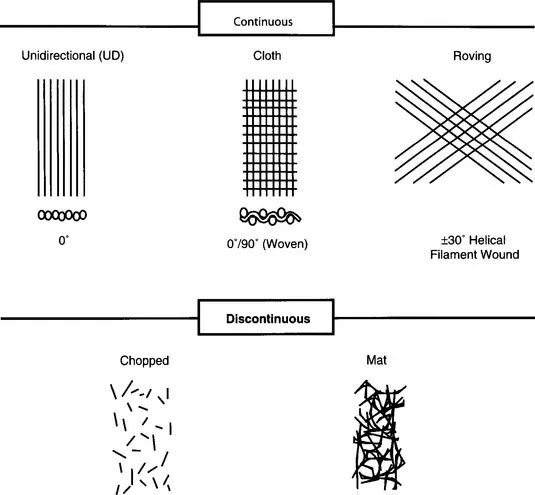
Fig. 1 Reinforcement Options
1.1 Laminates
Continuous-fiber composites are laminated materials (Fig. 2) in which the individual layers, plies or laminae are oriented in directions that enhance the strength in the primary load direction. Unidirectional (0°) laminates are extremely strong and stiff in the 0° direction; however, they are also very weak in the 90° direction because the load must be carried by the much weaker polymeric matrix. While a high-strength fiber can have a tensile strength of 500 ksi or more, a typical polymeric matrix normally has a tensile strength of only 5–10 ksi (Fig. 3). The longitudinal tension and compression loads are carried by the fibers, while the matrix distributes the loads between the fibers in tension and stabilizes and prevents the fibers from buckling in compression. The matrix is also the primary load carrier for interlaminar shear (i.e., shear between the layers) and transverse (90°) tension. The relative roles of the fiber and the matrix in determining the mechanical properties are summarized in Table 1.
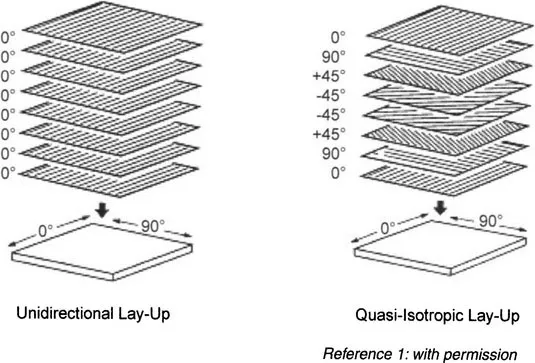
Fig. 2 Quasi-Isotropic Laminate Lay-Up
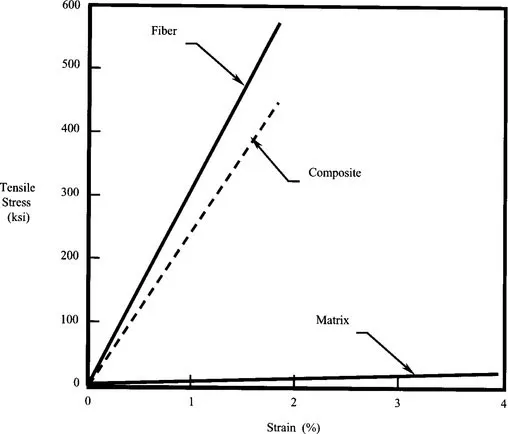
Fig. 3 Tensile Properties of Fiber, Matrix and Composite
Table 1.1 Effect of Fiber and Matrix on Mechanical Properties
| Mechanical Property | Dominating Composite Constituent | |
|---|---|---|
| Fiber | Matrix | |
| Unidirectional | ||
| 0° Tension | ✓ | |
| 0° Compression | ✓ | ✓ |
| Shear | ✓ | |
| 90° Tension | ✓ | |
| Laminate | ||
| Tension | ✓ | |
| Compression | ✓ | ✓ |
| In-Plane Shear | ✓ | |
| Interlaminar Shear | ✓ | |
Since the fiber orientation directly impacts the mechanical properties, it would seem logical to orient as many layers as possible in the main load-carrying direction. While this approach may work for some structures, it is usually necessary to balance the load-carrying capability in a number of different directions, such as the 0°, +45°, −45° and 90° directions. Fig. 4 shows a photomicrograph of a cross-plied continuous carbon fiber reinforcement in an epoxy resin matrix. A balanced laminate with equal numbers of plies in the 0°, +45°, −45° and 90° directions is called a quasi-isotropic laminate, since it carries equal loads in all four directions. Fig. 5 provides a graphical presentation of the preferred laminate orientations. These are preferred orientations because they are fairly balanced laminates that carry loads in multiple directions.
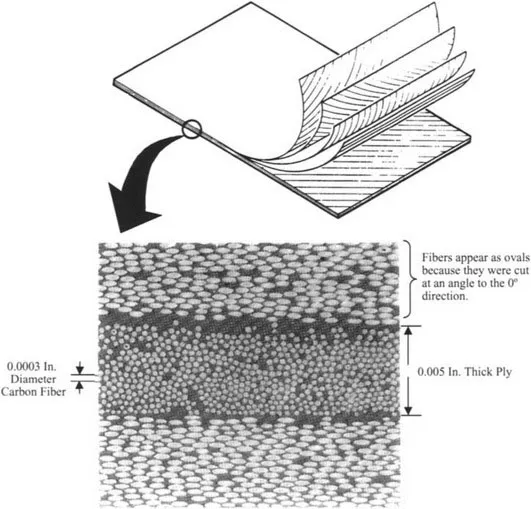
Fig. 4 Laminate Construction
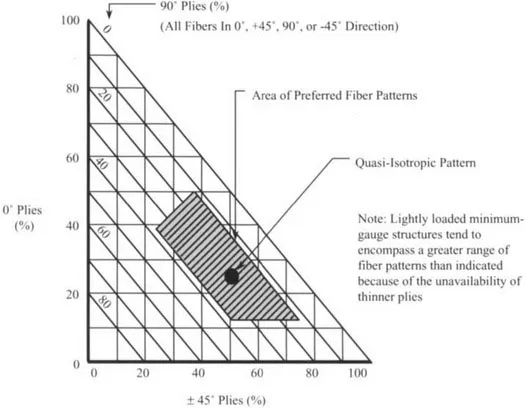
Fig. 5 Preferred Laminate Orientations
1.2 Fibers
The primary role of the fibers is to provide strength and stiffness. However, as a class, high-strength fibers are brittle; posses linear stress-strain behavior with little or no evidence of yielding; have a low strain to failure (1–2% for carbon); and exhibit larger variations in strength than metals. Table 2 presents a summary of the major composite reinforcing fibers.
Table 1.2 Properties of Typical High Strength Fibers
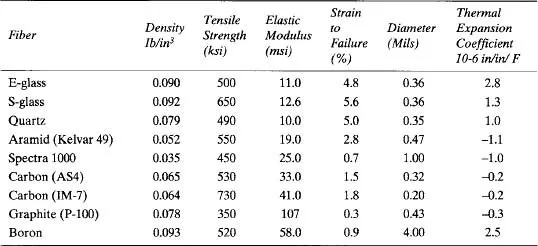
Glass fibers are the most widely used reinforcement due to their good balance of mechanical properties and low cost. E-glass, or “electrical” glass, is the most common glass fiber and is used extensively in commercial composite products. E-glass is a low-cost, high-density, low-modulus fiber that has good corrosion resistance and good handling characteristics. S-2 glass, or “structural” glass, was developed in response to the need for a higher-strength fiber for filament-wound pressure vessels and solid rocket motor casings. Its density value, performance level and cost lie between those of E-glass and carbon. Quartz fiber is used in many electrical applications due to its low dielectric constant; however, it is very expensive.
Aramid fiber (e.g., Kevlar) is an extremely tough organic fiber with low density, and exhibits excellent damage tolerance. Although it has a high tensile strength, it performs poorly under compression. It is also sensitive to ultraviolet light and its use should be limited to long-term service at temperatures less than 350 °F.
Another organic fiber is made from ultrahigh molecular weight polyethylene (UHMWPE; e.g., Spectra). It has a low density with excellent radar transparency and a low dielectric constant. Due to its low density, it exhibits very high specific strength and modulus at room temperature. However, being a polyethylene its use is limited to within 290 °F. Like aramid, Spectra has excellent impact resistance; however, poor adhesion to the matrix is a problem, although plasma treatments can be employed to improve the adhesion.
Carbon fiber contains the best combination of properties but is also more expensive than either glass or aramid. It has a low density, a low coefficient of thermal expansion (CTE) and is conductive. It is structurally very efficient and exhibits excellent fatigue resistance. It is also brittle (strain-to-failure less than 2%) and exhibits low impact resistance. Being conductive, it causes galvanic corrosion if placed in direct contact with aluminum. Carbon fiber is available in a wide range of strength (300–1000 ksi) and stiffness (modulus 30–145 msi). With this wide range of properties, carbon fibers (Table 3) are frequently classified as: (1) high-strength, (2) intermediate-modulus or (3) high-modulus fibers.
Table 1.3 Properties of PAN Based Carbon Fibers
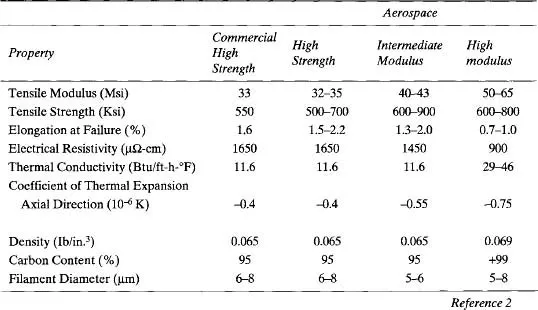
The terms carbon and graphite are often used to describe the same material. However, carbon fibers contain ~95% carbon and are carbonized at 1800–2700 °F, while graphite fibers contain ~99% carbon and are first carbonized and then graphitized at temperatures between 3600 °F and 5500 °F. In general, the graphitization process results in a fiber with a higher modulus. Carbon and graphite fibers are made from rayon, polyacrylonitrile (PAN) or petroleum-based pitch. PAN-based fibers produce the best combination of properties. Rayon was developed as a precursor prior to PAN but is rarely used today, due to its higher cost and lower yield. Petroleum-based pitch fibers were also developed as a lower cost alternative to PAN but are mainly used to produce high- and ultra-high-modulus graphite fibers. Both carbon and graphite fibers are produced as untwisted bundles called tows. Common tow sizes are 1k, 3k, 6k, 12k and 24k, where k = 1000 ...
Table of contents
- Cover image
- Title page
- Table of Contents
- Copyright
- Preface
- The Author
- Chapter 1: Introduction to Composite Materials and Processes: Unique Materials that Require Unique Processes
- Chapter 2: Fibers and Reinforcements: The String That Provides the Strength
- Chapter 3: Thermoset Resins: The Glue That Holds the Strings Together
- Chapter 4: Cure Tooling: You Can Pay Me Now …or Pay Me Later
- Chapter 5: Ply Collation: A Major Cost Driver
- Chapter 6: Curing: It’s a Matter of Time (t), Temperature (T) and Pressure (P)
- Chapter 7: The Effect of Chemical Composition and Processing on Carbon/Epoxy Laminate Quality: A Combination of Effects
- Chapter 8: Adhesive Bonding and Integrally Cocured Structure: A Way to Reduce Assembly Costs through Parts Integration
- Chapter 9: Liquid Molding: You Get a Good Preform and Tool … You Get a Good Part
- Chapter 10: Thermoplastic Composites: An Unfulfilled Promise
- Chapter 11: Commercial Composite Processes: These Commercial Processes Produce Far More Parts than the High-performance Processes
- Chapter 12: Assembly: The Best Assembly Is No Assembly Required
- Chapter 13: Nondestructive Inspection and Repair: Because Things Do Not Always Go As Planned
- Appendix-A: Metric Conversions
- Index